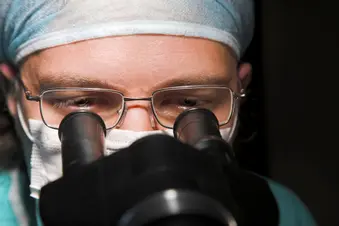
When your doctor diagnoses you with high levels of PSA (prostate specific antigen), they'll recommend that you have a prostate biopsy to find out if you have prostate cancer.
A biopsy (when the doctor takes a small piece of tissue to test in a lab) and a Gleason score can check for cancer and help see how fast-growing your cancer is.
What Is the Gleason Grading System?
Your Gleason score isn't a separate test. It's a number based on the results of your biopsy. You usually get it when you're first diagnosed with prostate cancer.
The doctor uses the numbers 1 to 5 to grade the most common (primary) and second most common (secondary) patterns of cells found in a tissue sample:
- Grade 1. The cells look very much like normal prostate cells.
- Grades 2-4. Cells that score lower look closest to normal and represent a less aggressive cancer. Those that score higher look the furthest from normal and will probably grow faster.
- Grade 5. Most cells look very different from normal.
The two grades added together are your Gleason score. Cancers will score 6 or more. A score of 7 means the cancer is intermediate, and a higher score (8 to 10) means the cancer is more likely to grow and spread.
Your doctor will use this combined score along with the results of your PSA blood test and digital rectal exam to see how advanced your prostate cancer is. They'll use this information to suggest the best treatment for you.
Transrectal Ultrasound-Guided Biopsy
For this procedure, the doctor takes a biopsy from your prostate. The tissue goes to a lab for testing. They can tell if you have cancer and, if so, how fast it might grow.
The biopsy takes about 10 minutes. You can get it done in your urologist's office. You will be awake for it. It usually doesn’t hurt much.
In the most common type of biopsy, your doctor places a device called an ultrasound probe in your rectum. It's about the width of a finger. It gives off sound waves that bounce off your prostate and create a black-and-white image on a video screen. A newer method uses an MRI scan to biopsy the prostate.
With the picture of your prostate as a guide, your doctor inserts a thin, spring-loaded, hollow needle through the wall of your rectum and into your prostate gland. As your doctor removes the needle, they take out a tiny bit of prostate tissue.
Because prostate cancer is rarely only in one area of the prostate, your doctor will take an average of 12 pieces of tissue, or samples, from different parts of your prostate. They may take more samples if they think they need to.
It's possible to have different types of cancer in the same prostate. Your doctor will get each tissue sample checked by a lab. The lab report will tell your doctor if cancer is present in each sample, how much of the tissue sample contains cancer, and your Gleason score.
Show Sources
(Photo Credit: Vasiliy Koval/Getty Images)
SOURCES:
Ketan Badani, MD, professor of urology, Icahn School of Medicine at Mount Sinai Hospital, New York City.
NCCN Guidelines for Patients: “Prostate Cancer.”
American Cancer Society: “Learn About Cancer: Prostate Cancer," "Understanding Your Pathology Report: Prostate Cancer."
National Institutes of Health: "International Society of Urological Pathology (ISUP) grading of prostate cancer -- An ISUP consensus on contemporary grading."